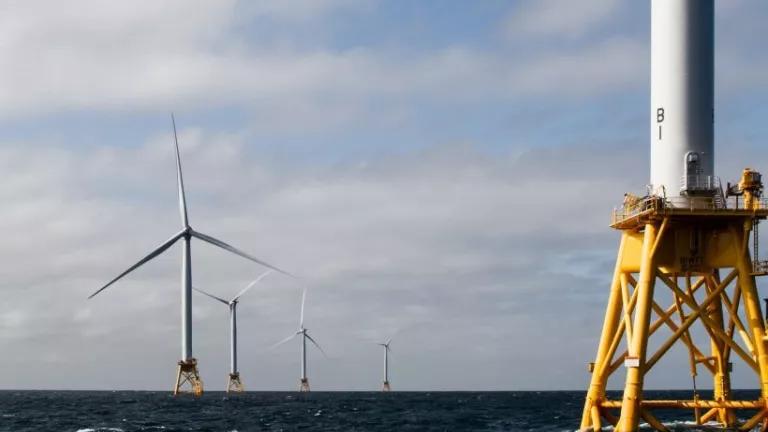Final North Atlantic Right Whale and Offshore Wind Strategy Released
New federal strategy aims to protect and promote the recovery of North Atlantic right whales while responsibly developing offshore wind energy.

Department of Energy
In a major step towards protecting and promoting the recovery of North Atlantic right whales while responsibly developing offshore wind energy, NOAA Fisheries and the Bureau of Ocean Energy Management (BOEM) have released the final North Atlantic Right Whale and Offshore Wind Strategy. The final strategy identifies the agencies’ goals and key actions to continue to evaluate and mitigate the potential effects of offshore wind energy development on North Atlantic right whales and their habitat. It also builds on existing mitigation measures to protect North Atlantic right whales from the potential impacts of offshore wind development.
Tapping offshore wind is critical to a healthier, fossil fuel-free future that avoids the worst impacts of the climate crisis. Along America’s shorelines, offshore wind is generally stronger and more consistent than onshore wind and a key puzzle piece for major coastal cities aiming to meet renewable energy needs. We need offshore wind, and we need to do it right.
Because the ocean life that we rely on for food, jobs, and recreation is struggling to adapt to a hotter, more acidic ocean—while already threatened from decades of overfishing, pollution, and habitat destruction—we must develop the new U.S. offshore wind industry in a smart, protective way. This need is particularly acute for endangered North Atlantic right whales, as their habitat overlaps with virtually all of the offshore wind areas being developed and planned for off the U.S. East Coast.
The North Atlantic right whale’s rapid decline stems primarily from vessel strikes and fishing gear entanglements, but the species faces a multitude of additional threats, including underwater noise pollution and malnourishment, all while fighting to adapt to climate change. With the species simply unable to withstand further loss or disturbance, the right whale crisis is not a problem caused by the offshore wind industry, but it is one the industry must face.

NOAA Northeast Fisheries Science Center/Lisa Conger and Elizabeth Josephson
The final strategy reinforces the Biden administration’s commitment to develop offshore wind and protect biodiversity, noting “both agencies share a common vision to protect and promote the recovery of [North Atlantic right whales] while responsibly developing [offshore wind] energy.” It is centered on reducing the risk to North Atlantic right whales from four primary stressors related to offshore wind development: exposure to noise, strikes from vessels, entanglement, and changes to habitat. To achieve this, the strategy identifies the need for the agencies to work together to identify and further develop effective mitigation measures and decision-support tools to reduce risk and avoid and minimize impacts to the species.
The strategy includes a list of the measures to avoid and minimize impacts to North Atlantic right whales from offshore wind activities and that should be considered in project construction. These measures include:
- Reducing noise levels during construction to the maximum extent practicable;
- Verifying that noise reduction targets during construction are met for each turbine that’s driven into the seafloor;
- Conducting underwater acoustic monitoring to listen for whales a full 24 hours in advance of loud foundation installation activities; and
- Ensuring a sufficient number of trained observers are deployed to keep watch for right whales during various activities.
Greater specificity on these best practices—and requirements that they be followed—is needed from the agencies. In particular, BOEM and NOAA should adopt a precautionary approach to reduce any additional risk of vessel strikes—one of the primary drivers of the species’ decline.
The strategy also highlights that regional monitoring and research are essential to answer key questions about if and how offshore wind affects wide-ranging species, like the North Atlantic right whale. Improved information will advise adaptive management so that we can quickly course correct if any impacts are identified. Importantly, the final strategy states a clear intention for coordination and alignment with the Regional Wildlife Collaborative for Offshore Wind (RWSC) Science Plan, which was released last month.
Identifying and securing funding to implement the final strategy is fundamental to its success—and should be a top priority for the administration and broader community. While federal agencies are already undertaking a number of activities that support the final strategy, funding has not yet been secured for its full implementation. Only by dedicating a steady stream of resources to this effort will agencies be able to stand up the called-for interagency implementation team and allow this to be the “living” document that’s envisioned.
We must invest in meeting our nation’s offshore wind power goals while also protecting one of its most beloved marine species. The Final North Atlantic Right Whale and Offshore Wind Strategy provides a roadmap, but one that will require consistent attention and staff and financial commitment.




